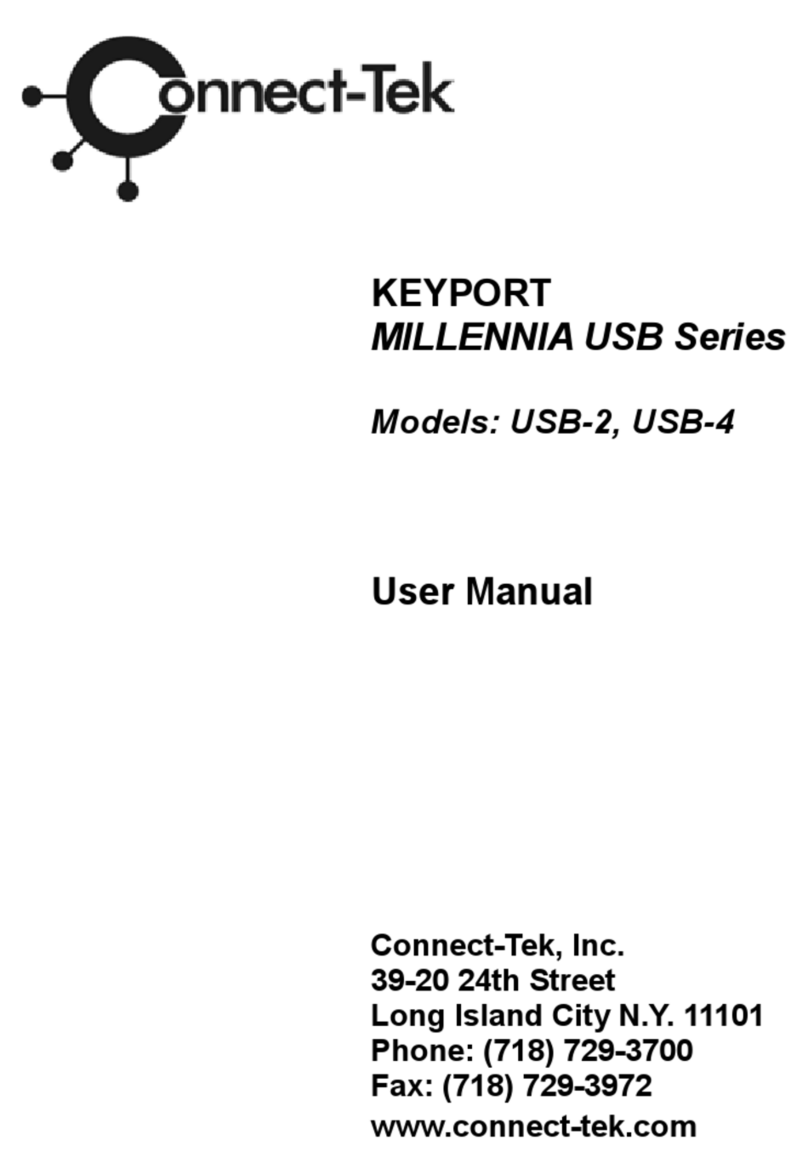11
Function key F3 : To lock a computer from unauthorized
access. To lock a device, highlight it then press F3 . Now, enter
up to 4 characters (‘A’~’Z’, ‘0’~’9, ‘-‘) followed by Enter as new
password. A Security-enabled device is marked with a lock (±)
following its port number. To permanently disable the security
function from a locked device, highlight it, press F3 then enter the
password.
The color of a device name is green if it has power and is ready for
operation, or the color is white, if it has no power. OSD menu updates
the color when it is activated. The PageUp and PageDown keys can
be used to view 8 other computers at a time, with USB-8, for example.
For example, with the USB-16, use the “ “, “ “, “ 1“ ~ “ 8 “, or “ A
“ ~ “ H“ to highlight a computer and then press the Enter key to
select it. Or, you may press the Esc key to exit OSD and remove the
OSD menu from the display; the status window returns to the display
and indicates the currently selected computer or operating status. A
triangle mark () to the right of a name indicates the port is cascaded
to a Slave; the number at the left of the triangle mark shows the number
of ports the Slave has, i.e. 8for an 8-port switch. The Enter key
brings you one level down and another screen pops up listing the
names of the computers on that Slave. The name of the Slave will be
shown at the upper right corner of the OSD menu. It is useful to group
computers and still be able to see the group name.
If you want to access the locked device temporarily, simply
highlight it and press Enter , the OSD will ask you for the
password. After entering the correct password, you are allowed to
use the device. This device is automatically re-locked once you
switch to another port. During Scan mode, OSD skips the
password-protected ports.
If you forget the password, the only way to permanently
erase all the passwords is to:
For USB-8 and USB-16, press and hold the front panel
buttons “1” and “2”, then hold “7” and “8”. Release “7” and
“8”, then release “1” and “2”.
An eye mark (1) to the right of a name indicating the computer is
selected to be monitored in Scan mode. In OSD, this mark can be
switched on or off by the function key F2 .
Function key F4 : More functions are available by hitting F4 .
A new screen pops up displaying more functions as described
below. Most of them are marked with a triangle () indicating
there are options to choose from. Using the UP and DOWN
arrow keys, select the functions and press Enter . Available
options will be shown in the middle of the screen. Again, using the
UP and DOWN arrow keys to view options then press Enter to
select it. You can press Esc to exit at any time.
Press the Esc key to exit OSD and to return to the selected computer;
the computer name is also shown on the screen.
Function key F1 : To edit name entry of a computer or a Slave
with up to 14 characters. First, highlight a port then press F1
followed by name entry. Valid characters are ‘A’~’Z’, ‘0’~’9’ and the
dash character. Lowercase letters are converted to uppercase
ones. Press Backspace to delete a letter one at a time.
Non-volatile memory stores all name entries until you change,
even if the unit is powered down.
Auto Scan
In this mode, the USB KVM automatically switches from
one powered-on computer to the next sequentially in a
fixed interval. During Auto Scan mode, the OSD displays
the name of the selected computer. When Auto Scan
detects any keyboard or mouse activity, it suspends the
scanning until activity stops; it then resumes with the next
computer in sequence. To abort the Auto Scan mode,
press the left Ctrl twice, or, press any front button. Scan
Type and Scan Rate set the scan pattern. Scan Type ( F4 :
Function key F2 : To switch the eye mark (1)of a computer on
or off. First, use the UP and DOWN arrow keys to highlight it,
then press F2 to switch its eye mark on or off. If Scan Type is
'Ready PC +1', only the power-on and eye mark selected
computers will be displayed sequentially in Scan mode.
10




























